
ford catalytic converter identification guide
A Ford catalytic converter is essential for reducing emissions and ensuring engine efficiency. Identifying the correct converter is crucial for maintenance, performance, and environmental compliance. This guide provides detailed steps to help Ford vehicle owners accurately identify their catalytic converters using VIN, visual inspections, and online resources, ensuring proper replacement and optimal functionality.

What Is a Catalytic Converter?
A catalytic converter reduces harmful emissions, improving engine efficiency. Its core is a ceramic monolith with honeycombed channels for exhaust gas flow, essential for vehicle performance and environmental compliance.
2.1. Purpose of a Catalytic Converter
The primary purpose of a catalytic converter is to reduce harmful emissions by converting pollutants like carbon monoxide, hydrocarbons, and nitrogen oxides into less harmful gases. This ensures compliance with emissions standards, improves air quality, and enhances engine performance. By facilitating chemical reactions within the exhaust system, the converter plays a critical role in maintaining both environmental sustainability and vehicle efficiency, making it an indispensable component in modern vehicles;
2.2. Components of a Catalytic Converter
A catalytic converter consists of a ceramic monolith with a honeycombed structure, allowing exhaust gases to flow through numerous small channels. This monolith is coated with catalytic materials like platinum, palladium, and rhodium, which facilitate chemical reactions to reduce pollutants. The converter is encased in a stainless steel shell for durability and heat resistance, with inlet and outlet pipes connecting it to the exhaust system. These components work together to minimize emissions while maintaining engine efficiency and performance.

How to Locate the Catalytic Converter on a Ford Vehicle
Located in the exhaust system, near the engine. Raise the vehicle to access it. Look for a cylindrical shape with an expansion joint nearby.
3.1. Location of the Catalytic Converter
The catalytic converter is located in the exhaust system, typically near the front of the vehicle, under the chassis. It is usually positioned between the engine and the muffler, near the front axle. On most Ford vehicles, it is mounted close to the exhaust manifold for optimal performance. The converter is bolted to the vehicle’s undercarriage and may be protected by a heat shield. Its location allows it to effectively reduce emissions as exhaust gases flow through the system.
3.2. Physical Description and Appearance
A Ford catalytic converter typically has an oval or cylindrical shape, made of durable stainless steel for longevity. It features an inlet and outlet for exhaust gas flow, with a heat shield to protect surrounding components. The size varies depending on the vehicle model and engine type. The exterior is usually smooth with visible welds or seams. Inside, it contains a honeycomb or ceramic substrate coated with catalytic materials. Genuine Ford converters often have distinct OEM markings or stamps for identification purposes.
Identifying a Ford Catalytic Converter Using the Vehicle Identification Number (VIN)
The VIN helps accurately identify the correct catalytic converter for your Ford vehicle by decoding specific characters that reveal engine type and emissions standards. Always use official Ford databases or dealership resources to ensure compatibility and compliance with emissions regulations. This method guarantees the right fit and performance for your vehicle.
4.1. How to Find and Use the VIN
The Vehicle Identification Number (VIN) is a 17-character code found on the driver’s side dashboard near the windshield, on the driver’s doorjamb, or under the hood. It can also be located on the vehicle’s title or registration. To use the VIN, visit Ford’s official website or contact a dealership to access their database. Enter the VIN to retrieve specific details about your vehicle, including the catalytic converter model. This ensures compatibility and compliance with emissions standards, eliminating guesswork and guaranteeing the correct part for your Ford.
4.2. Decoding the VIN for Converter Information
Decoding the VIN reveals specific details about your Ford vehicle, including the engine type, model year, and emissions standards. Positions 1-3 and 10-11 of the VIN are particularly relevant for identifying the catalytic converter. These sections indicate the manufacturer, engine code, and emissions system. By analyzing these codes, you can determine the exact catalytic converter required for your vehicle, ensuring compliance with emissions regulations and proper system performance. This method is reliable and eliminates the need for physical inspection or guesswork.
4.3. Cross-Referencing with the Manufacturer’s Part Number
Cross-referencing the VIN-derived information with Ford’s manufacturer part number ensures accuracy in identifying the correct catalytic converter. Visit Ford’s official parts database or consult a dealership to input the VIN and retrieve the corresponding part number. This number will specify the exact converter designed for your vehicle, ensuring proper fitment and emissions compliance. Always verify the part number against Ford’s OEM documentation to avoid mismatches and guarantee optimal performance.

Visual Inspection for Identification
Visual inspection helps confirm the catalytic converter’s authenticity and condition by checking for Ford OEM markings, serial numbers, and evaluating its build quality and size.
5.1. Checking for Ford OEM Markings
Inspecting for Ford OEM (Original Equipment Manufacturer) markings is crucial for verifying authenticity. These markings typically include the Ford logo, part number, or “OEM” stamp, usually found on the catalytic converter’s shell or end pipes. Genuine Ford converters often have these markings stamped or engraved, ensuring compliance with factory specifications. To verify, clean the converter surface and visually inspect for legible markings. Compare them with Ford’s official documentation or consult a dealership to confirm authenticity. This step helps distinguish genuine parts from counterfeit ones, ensuring proper performance and compliance. Always cross-reference markings with Ford’s database for accuracy.
5.2. Locating and Reading the Serial Number
Locating the serial number on a Ford catalytic converter is essential for identification. It is typically found on the side of the converter or near the inlet/outlet pipes. Use a flashlight to illuminate the area, as the number may be small or faint. The serial number is usually a series of letters and numbers that correspond to Ford’s manufacturing records. Once located, record the number and cross-reference it with Ford’s database or a dealership to verify authenticity. This step ensures the converter is genuine and properly matched to your vehicle.
5.3. Assessing Build Quality and Size
Assessing the build quality and size of a Ford catalytic converter is crucial for identification. Inspect the converter for robust construction, ensuring it matches Ford’s OEM standards. Check for clean welds, a sturdy heat shield, and a solid substrate. Measure the length, diameter, and inlet/outlet pipe sizes to confirm they align with Ford specifications. Proper sizing ensures correct fitment and optimal performance. Any deviations may indicate a mismatch or aftermarket part. Always compare against Ford’s dimensional charts for accuracy.

Using Online Resources for Identification
Utilize Ford’s official website, databases, and third-party tools to identify catalytic converters. These resources provide detailed part numbers, compatibility, and images. Enter the VIN or part number to find exact matches. Cross-reference with repair manuals or forums for additional insights. This method ensures accuracy and saves time. Always verify sources for reliability.
6.1. Accessing Manufacturer’s Databases
Ford provides an official Parts Catalog or Service Portal for identifying catalytic converters. Log in to these databases using the VIN or part number to find compatible units. Detailed listings include part numbers, descriptions, and images. Cross-reference with repair manuals for accuracy. Manufacturer databases ensure precise identification, reducing the risk of purchasing incorrect converters. Always verify authenticity by contacting Ford support if needed. This method is reliable for ensuring the correct part is selected for your vehicle.
6.2. Utilizing Third-Party Identification Websites
Third-party websites like RockAuto or AutoZone allow users to input their vehicle’s details to identify compatible catalytic converters. These platforms provide part numbers, images, and compatibility information. They often include customer reviews and pricing, aiding in informed decisions. While convenient, ensure the website is reputable and cross-reference with Ford’s official specifications for accuracy. These tools are particularly useful for comparing options or finding aftermarket alternatives that meet OEM standards, ensuring reliability and performance for your Ford vehicle.

Signs of a Faulty Catalytic Converter
A faulty catalytic converter may cause reduced engine performance, decreased fuel efficiency, or trigger a “check engine” light. Internal damage or clogging can lead to these issues.
7.1. Common Symptoms to Look For
Common symptoms of a faulty Ford catalytic converter include a illuminated “check engine” light, rough engine idling, or stalling. Drivers may notice reduced engine power,
- Decreased fuel efficiency.
- Failed emissions tests.
- A noticeable sulphur or egg-like odor from the exhaust.
- Unusual rattling or hissing sounds from the converter.
These issues often indicate internal damage or clogging within the converter, requiring immediate attention to avoid further engine damage.
7.2. Diagnostic Trouble Codes (DTCs)
When a Ford catalytic converter fails, specific Diagnostic Trouble Codes (DTCs) are triggered. Common codes include P0420 (Catalyst System Efficiency Below Threshold) and P0430 (Catalyst System Efficiency Below Threshold for Bank 2). These codes indicate poor converter performance. Other related codes may include P0411 (Secondary Air Injection System) or P0443 (Evaporative Emission Control System). These codes are retrieved using an OBD-II scanner and help pinpoint issues. However, DTCs alone don’t always confirm a faulty converter, as they can also indicate upstream sensor or system malfunctions.

Steps for Removing the Catalytic Converter
Raising the vehicle, remove heat shields and disconnect oxygen sensors. Use a wrench to remove bolts securing the converter. Carefully lower it for replacement.
8.1. Tools and Safety Precautions
Essential tools include wrenches, oxygen sensor sockets, and heat-resistant gloves. Ensure proper ventilation and wear safety glasses. Disconnect the battery and use jack stands for stability. Handle hot components cautiously and avoid sparks near the exhaust system. Keep a fire extinguisher nearby. Always follow Ford’s recommended safety guidelines to prevent accidents and ensure a secure working environment during the removal process.
8.2. Physical Removal Process
Begin by raising the vehicle on a lift or jack stands for safe access. Remove any heat shields or components obstructing the catalytic converter. Disconnect the oxygen sensors and exhaust system flanges using a wrench. Carefully loosen the converter’s mounting bolts and slide it out of the exhaust system. Avoid damaging surrounding components. Once free, lift the converter straight out, taking note of its weight and size. Handle with care to prevent damage or injury.
Steps for Replacing the Catalytic Converter
Install the new converter by aligning it with the exhaust system, ensuring proper gasket placement. Tighten the mounting bolts securely and reconnect the oxygen sensors. Reattach any heat shields and test the exhaust for leaks. Start the engine to verify operation and ensure no error codes persist. Complete the process with a test drive to confirm proper functionality.
9.1. Installation Process
Raise the vehicle using a lift or jack stands for safe access. Remove the old catalytic converter and inspect the mating surfaces. Apply a new gasket to the exhaust system flange. Carefully install the new converter, ensuring it aligns with the flange and oxygen sensor ports. Tighten the bolts gradually to avoid warping the flange. Reconnect the oxygen sensors and any heat shields. Lower the vehicle and start the engine to check for leaks or unusual noises. Verify proper operation before test driving.
9.2. Post-Installation Checks
After installing the new catalytic converter, start the engine and listen for any unusual noises or leaks. Use an OBD-II scanner to ensure no trouble codes are present. Take the vehicle for a test drive to monitor performance and check for warning lights. Inspect the exhaust system for proper connection and ensure all heat shields are securely fastened. Verify that the oxygen sensors are functioning correctly and that the exhaust flow is unrestricted. Address any issues promptly to ensure optimal performance and prevent further damage.

Cost Considerations and Replacement Options
Catalytic converter costs vary widely, depending on OEM or aftermarket options. Factors include vehicle model, converter type, and labor fees. Warranty and quality differences impact pricing decisions.
10.1. OEM vs. Aftermarket Converters
OEM catalytic converters are designed to meet Ford’s exact specifications, ensuring optimal performance and compliance with emissions standards. They are typically more expensive but come with a manufacturer warranty. Aftermarket converters offer a cost-effective alternative, often at a lower price point, but may vary in quality and durability. While aftermarket options can be reliable, they may not always match the OEM’s build quality or warranty coverage. Choosing between the two depends on budget, desired longevity, and compliance requirements.
10.2. Factors Affecting Replacement Cost
The cost of replacing a Ford catalytic converter varies based on several factors. The type of converter—OEM or aftermarket—affects pricing, with OEM being more expensive. Labor costs at repair shops also differ, depending on location and expertise. The vehicle’s model and year influence the price, as newer or high-performance models may require specialized converters. Additionally, availability, shipping fees, and local taxes can increase the total cost. It’s essential to research and compare prices to find the best option for your budget and vehicle needs.
Legal and Environmental Considerations
Legal requirements mandate catalytic converters to meet emissions standards, while environmental concerns highlight the need for proper disposal to prevent pollution from precious metals like platinum and palladium.
11.1. Legal Requirements for Catalytic Converters
Catalytic converters are regulated by emissions standards set by government agencies like the EPA. Ford must ensure converters meet these requirements to reduce pollutants. Replacement converters must comply with EPA standards, and using non-compliant units is illegal. Proper documentation is required for installation, and tampering or removing converters violates federal law. Penalties include fines and legal action. Compliance ensures environmental protection and avoids legal consequences for drivers and repair shops.
11.2. Environmental Impact of Proper Disposal
Proper disposal of catalytic converters is crucial due to their high content of precious metals like platinum and palladium. Improper disposal can lead to environmental contamination, as these metals can leach into soil and water. Recycling ensures these materials are safely reclaimed and reused, reducing the need for mining and conserving natural resources. Correct disposal also minimizes pollution and supports sustainable practices. Recycling programs for catalytic converters are widely available, making eco-friendly disposal both responsible and accessible.
Maintenance Tips to Prolong Converter Life
Regular engine tune-ups, avoiding harsh driving conditions, and preventing oil or coolant leaks help maintain catalytic converter health. Ensuring proper fuel combustion and avoiding aggressive driving prolongs its lifespan.
12.1. Regular Inspections
Perform routine visual inspections of the catalytic converter for signs of damage, rust, or leaks. Check the exhaust system for blockages or wear, as these can strain the converter. Monitor for unusual sounds or vibrations, which may indicate internal damage. Schedule inspections every 30,000 to 50,000 miles or as recommended by Ford. Use diagnostic tools to check for codes related to converter efficiency. Addressing issues early prevents costly repairs and ensures optimal performance. Regular checks help identify potential problems before they escalate.
12.2. Avoiding Contaminants
To prolong the life of your Ford catalytic converter, avoid exposing it to contaminants like oil, fuel, or coolant. Regular oil changes and inspecting fuel injectors can prevent oil contamination. Ensure the cooling system functions properly to avoid coolant leakage into the exhaust. Using the correct fuel type for your vehicle is essential to prevent internal damage. Avoiding contaminants reduces the risk of premature failure and maintains optimal performance. Regular maintenance helps preserve the converter’s efficiency and longevity.

Troubleshooting Common Issues
Identify issues like reduced performance or error codes. Check for clogs, damaged sensors, or faulty wiring. Use diagnostic tools to pinpoint problems and determine repair needs.
13.1. Diagnosing Faults
Diagnosing faults in a Ford catalytic converter involves checking for common issues like clogs, overheating, or failed emissions. Look for symptoms such as reduced engine performance, rattling noises, or the “check engine” light. Use an OBD-II scanner to retrieve diagnostic trouble codes (DTCs), which can indicate converter-related problems. Inspect the converter for physical damage, rust, or corrosion. Compare upstream and downstream oxygen sensor readings to identify inefficiencies. If issues persist, consult a professional to avoid further engine damage. Early diagnosis prevents costly repairs and maintains emissions compliance.
13.2. Repair vs. Replace Decisions
Deciding to repair or replace a faulty Ford catalytic converter depends on the extent of damage and cost. Minor issues like clogs may be cleaned, while severe damage often requires replacement. Consider the converter’s age and overall condition. Repairing can be cost-effective for partial damage, but replacing is often more reliable for long-term performance. Compare repair costs with the price of a new unit, including labor fees. New converters offer warranties and improved emissions efficiency. Always consult a professional for an accurate assessment and recommendation.

Frequently Asked Questions (FAQ)
- Q: Why is identifying my Ford catalytic converter important?
A: Proper identification ensures the correct replacement, maintains performance, and complies with emissions standards.
- Q: Can I replace my catalytic converter myself?
A: Yes, but it requires specialized tools and knowledge. Consulting a professional is recommended.
- Q: How long does a catalytic converter typically last?
A: It can last 10+ years, but factors like mileage and maintenance affect its lifespan.